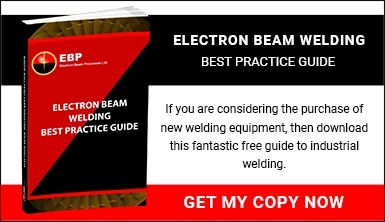Electron beam welding is a vital art in many core industries. These include aerospace, oil and gas, and medical equipment. EB welding was invented in the 1950s, which was a time when fusion was very much in vogue. However, electron beams have stood the test of time in terms of their real-world applications. Being able to tightly control electron beams via the combination of a vacuum and precision calculations gives engineers formidable levels of control.
Peter Vincent
Recent Posts
How To Control The Quality Of Electron Beam Welding
Topics: Electron Beam Welding
The electron beam welding (EBW) process is a method of melting metals together to form a joint. A powerful and highly accurate beam of electrons is fired at the joint, causing the material to melt and then re-solidify to create the weld zone. If there is one word that comes to mind when EB welding is mentioned, it’s vacuum. There are three main reasons that a vacuum is used.
Topics: Electron Beam Welding
Electron beam welding (EBW) has many applications and uses. As demands for precision technology grow, so too does the uptake of EBW in a range of sectors.
Topics: Electron Beam Welding
Put very simply, electron beam welding (EBW) is a process whereby two metals are fused or welded together using a beam of high-velocity electrons. This type of welding is suited to applications requiring high-precision, very good repeatability and high-strength.
Topics: Electron Beam Welding
Electron Beam Welding: Advantages & Disadvantages
Electron beam welding (EBW) is a metal welding technique which takes place in a vacuum chamber using a beam of high energy electrons to heat the metal. This melts the material, creating a ‘keyhole’ which then solidifies as it fuses with another component.
Topics: Electron Beam Welding
One of the distinguishing features of EB welding is that it requires a vacuum to be successful. Why is this?
Topics: Electron Beam Welding
Electron Beam Welding (EBW) is one of several methods used to weld metal components together. It differs from other processes in several important ways, which will be explained in this article. EBW has unique abilities for welding dissimilar metals, complex or curved components and precision parts.
Topics: Electron Beam Welding
Electron Beam Welding (EBW) and Laser Beam Welding (LBW) and are both fusion welding techniques that use a high energy density beam to melt the joint of two components. Both methods have fast cycle times and produce high weld quality. They are similar and can be used side-by-side in some circumstances, but they are not identical.
Topics: Electron Beam Welding, Laser Welding
We have strengthened our arc welding capability as part of our suite of market leading welding solutions, with a new workshop and all new equipment. We are a full capability welding specialist committed to the highest weld quality – meeting the needs of complex projects in the aerospace, defence, nuclear, medical equipment, and with approvals from the most demanding OEMs.
Topics: Arc Welding
Digital Film for Radiography, investment in equipment and training by EBP has now resulted in approval for from Rolls-Royce plc for this process.
Topics: News










